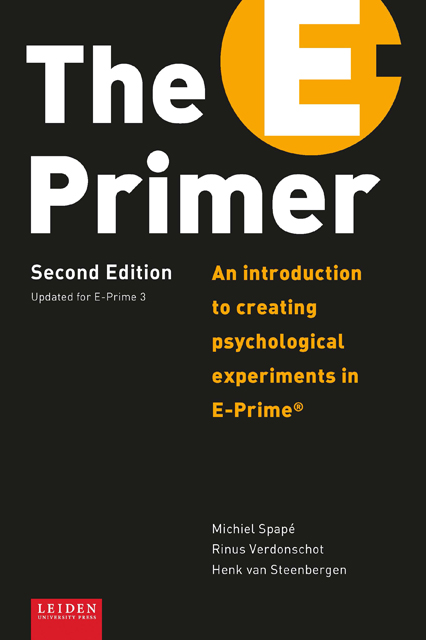Book contents
- Frontmatter
- Table of Contents
- Preface to the Second Edition
- Preface to the First Edition
- Introduction
- Chapter I E-Prime at a glance
- Chapter II List Attributes and Slides
- Chapter III Sound, movies, hardware, and nested Lists
- Chapter IV Beginning programming in E-Prime
- Chapter V Decision making in E-Basic
- Chapter VI Loops and Arrays in E-Basic
- Chapter VII Interactions between Slide objects and the Mouse
- Chapter VIII Various Input/Output devices
- References
- Appendix: Overview of available E-Objects
- About the authors
- Index
Introduction
Published online by Cambridge University Press: 22 November 2022
- Frontmatter
- Table of Contents
- Preface to the Second Edition
- Preface to the First Edition
- Introduction
- Chapter I E-Prime at a glance
- Chapter II List Attributes and Slides
- Chapter III Sound, movies, hardware, and nested Lists
- Chapter IV Beginning programming in E-Prime
- Chapter V Decision making in E-Basic
- Chapter VI Loops and Arrays in E-Basic
- Chapter VII Interactions between Slide objects and the Mouse
- Chapter VIII Various Input/Output devices
- References
- Appendix: Overview of available E-Objects
- About the authors
- Index
Summary
The E-Primer is written with a reader in mind who is eager to learn, but knows little, if anything, about programming, computer science and the actual implementation of all those wonderful scientific experiments that populate the reading lists of psychologists and cognitive scientists. This is not to say, however, that more experienced readers will not find it instructive, as many chapters also deal with advanced E- Prime and programming skills.
What is E-Prime and what will I learn?
E-Prime® is a software package developed and distributed by Psychology Software Tools, Inc. It is specially designed to facilitate development of custom psychological experiments, and to acquire and analyse data. E-Prime consists of several programs with different functions. In The E- Primer, we will discuss E-Studio, E- Basic, E-Merge, E-Recovery and E-DataAid. We will assume you are using E-Prime 2 or 3, but most of the features we discuss were already introduced in E-Prime 1. When versions differ significantly in operation, we discuss each version separately.
You will learn how to use each of these programs effectively, ultimately in order to implement your very own experiments. First, however, you will learn how to recreate a number of fascinating, famous experiments. We will guide you through this process in an easy-to-follow, step-by-step approach – ‘now click on this button over here’ – using Tutorials. Along the way, we’ll explain the reasoning behind each step and give you tips on good practice in experimental design. Gradually, we will move beyond the narrow confines of ‘click-here-now-click-there’ and ask you to implement simple variations on the experiments you’ve met so far. These form the Exercises at the end of each chapter. Finally, in the Additional Exercises, you will be invited to explore, with minimal guidance, the horizons of E- Prime and how you could use what you’ve learned to implement your own research questions. Always make sure that you save your work, because you may need it in subsequent chapters.
Why should I learn E-Prime?
There are a number of reasons to learn E-Prime. First, many students will become involved in a research project during their studies. This will eventually involve setting up and programming an experiment, which requires good E-Prime programming skills.
- Type
- Chapter
- Information
- The E-PrimerAn Introduction to Creating Psychological Experiments in E-Prime, pp. 13 - 16Publisher: Amsterdam University PressPrint publication year: 2019



